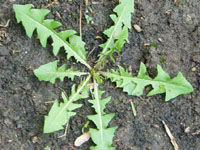Herb for an Apprentice: Dandelion
what counts as a mistake?
Although some places are still under snow, it's feeling like spring here. Several 80+ degree days here this week, some more rain today. I'm told that this my first winter/spring in Tucson has been a kindly one in terms of the volume of rain we've been gifted.
The rains gift a spectacular blooming of this desert place. As the trees leaf out and all sorts of small weeds unfurl from the ground, there are flowers everywhere. My neighbor's magenta bougainvillea vine. Cactus and yucca and agaves sprouting spiky and marvelous inflorescences. Mesquite trees covered in yellow blossoms and bees.
A time of beginnings for plants, then. In other words, there were so many choices available to me for a plant related to the theme of apprenticing and beginning. (Mindfulness post and word post for this series.)
We smudged with desert lavender to set good intentions for the apprenticeship, so that would have been a good choice. But John, the herbal master, has already written eloquently about desert lavender, and I don't yet have a strong relationship with it. Go read his article!
Almond! Shakud, in Hebrew--harbinger of spring. And with the flower fairies--I still have the almond blossom fairy's song in my head. But I haven't seen any almond trees here.
Dandelion, though. Even without the flower--and it's not yet blooming here, mostly--I bet you could identify the dandelion from the picture, so you have a relationship with it. I have a lifelong relationship with it, too. I ate the flowers and blew "dandelion clocks" as a kid. I've made medicines, teas, salads, wines, from all parts of the plant in the many places I've lived. And, more recently, I have an "apprentice's mistake" to share involving dandelion. Perhaps you can help me decide whether it was a mistake or not.
Dandelion lives almost everywhere. (Versatility's a good quality for an apprentice, too.) In many places, it's the first nectar flow for bees after winter (so in Alaska that would be June), and it's often used as a familiar emblem of the bitter greens of springtime, the urge for "spring cleaning" after the inertia of winter. It's cleansing to the liver-gallbladder system and supportive to the kidneys.
Star, Tooth, Pee
Dandelion is in the Asteraceae family, which refers to its composite flowers (many tiny flowers, not the five-petal child's-drawing flower). It's a giant family, including food (lettuce, chicory, artichoke), medicine (echinacea, chamomile, wormwood), and even some trees.
Aster is Greek for star, and dandelion is kind of starry. Its flowers starry like the sun, its seeds like starbursts in and out of sight as they drift. It's also star-like in how it tracks the seasons, like a horoscope. It'll come up and bloom again in the late fall, or any time. Apprentice, follow the star of the plant you're learning from.
When I was a kid, I thought dandelion meant "dandy lion." You can picture it, right? Big smiley lion's face in that yellow flower, all suave and duded up in its green filigree... And then I learned some French--dent de lion is lion's tooth. And then some German. Loewenzahn is also lion's tooth.
It's about those deeply serrated leaves. Sharp, well spaced, and full of medicine. Apprentice: Cut clean. Make space. Approach your learning with the fierce focus of a lion biting.
Did you know that another name for dandelion is piss-a-bed, or in French, pissenlit? Your mom didn't tell you that one? Too much dandelion for dinner or nightcap and you might want to take the chamber pot to bed, I guess. Yes, it's known as a diuretic, but in my experience it isn't nearly as strong a diuretic as uva ursi, or even yerba mate. Apprentice, listen to the old stories ,but form your own impressions and relationships.
Speaking of forming our own relationships, here's my "mistake" story. It's my first year here, remember. I found what looked very much like dandelion to me and was delighted.
I took a small piece, ate it slowly, stayed with its energy for a bit. And then started eating it enthusiastically. I harvested a few leaves from each plant I came across, and enjoyed them thoroughly.
Succulent, juicy, a little dry, distinctly bitter, springtime sour. How does it manage to be dry and juicy at the same time? It's those dorsal veins, bursting with water, and those flat leaves, maximum surface area to exchange gases with the air around it.
The one new thing about this Tucson dandelion was these little spines along the dorsal vein--a local adaptation? I wondered.
Then I asked John, the master herbalist, and he told me this isn't dandelion at all; it's lactuca, wild lettuce, and those spines are exactly the identifying feature.
How much of a mistake did I make?
- This plant was from the same family as dandelion
- I didn't go hog-wild (or lion-wild, or pee the bed); I took a small sample and sat with it first
- Despite thinking I knew what it was, I fostered a relationship with this particular plant separate from the one I was comparing it to
In other words, there's no way I could have poisoned myself with this plant. I sincerely believe that disastrous kind of mistake can't happen if one always approaches the plant as an apprentice. If you look at the names of plants, it's obvious how often a plant has been mistaken for one of its cousins, so my mistake was part of a tradition. But there are poisonous plants that look like benign ones, so it's a helpful warning.
Otherwise, just as prayers acknowledge that we don't know the true name of the divine but invoke it/her/him nonetheless, we approach the plant with the same reverence, no matter the name.
